David Pearson's experience in real life book cover design, and how his experimentation with different design methods helped create exciting and unique book covers.
Category: events
13 July: a celebration of letterforms and ephemera
Real Jobs: Celebrating over five decades of professional design practice on our undergraduate course
Alongside our degree show opening last week, we also launched a new exhibition celebrating our ‘Real Jobs’ scheme.
Real Jobs has been our flagship professional experience programme for as long as Typography has existed as a department. It allows our students their first taste of working alongside clients to co-create, and deliver on, a design brief. Our graduates regularly tell us that their experiences on these projects exposed them to unique and powerful moments that helped them secure their first paid positions, and continue to inform their professional practice today.
Standout projects on display include the Tomos Jones’ recent gold medal-winning University display at the Chelsea Flower Show and Maddi Davies’ collaborative project on Margaret Atwood, Second Sight. But a full range of work is on show, everything from books to branding, and we hope it is a fitting tribute to the students, staff and clients who have contributed to making Real Jobs such a successful part of the curriculum here in Typography.
The exhibition runs until 28 June. If you’ve ever been a client of Real Jobs, or if you’d like to know more about how the scheme could help your project or organisation, please do stop by to enjoy this celebration of five decades of students’ first steps into the world of professional graphic design.
To see our archive of recent Real Jobs, click here. If you think you have a project that would benefit from student design support you can also book in your own project here.
“I believe this is a great scheme, both supporting students with real life projects and work experience and also providing great value to small companies in need of professional design support” – Sirin Myles, International Education Consultant
“The Real Jobs scheme is an excellent way for students to get experience working towards a brief and is a great way to help everyone involved gain experience that will be useful when transitioning into a working environment. I will be recommending the scheme to my employer as I believe it provides unique opportunities for all involved.” – Isabel Cash, Holland House Books
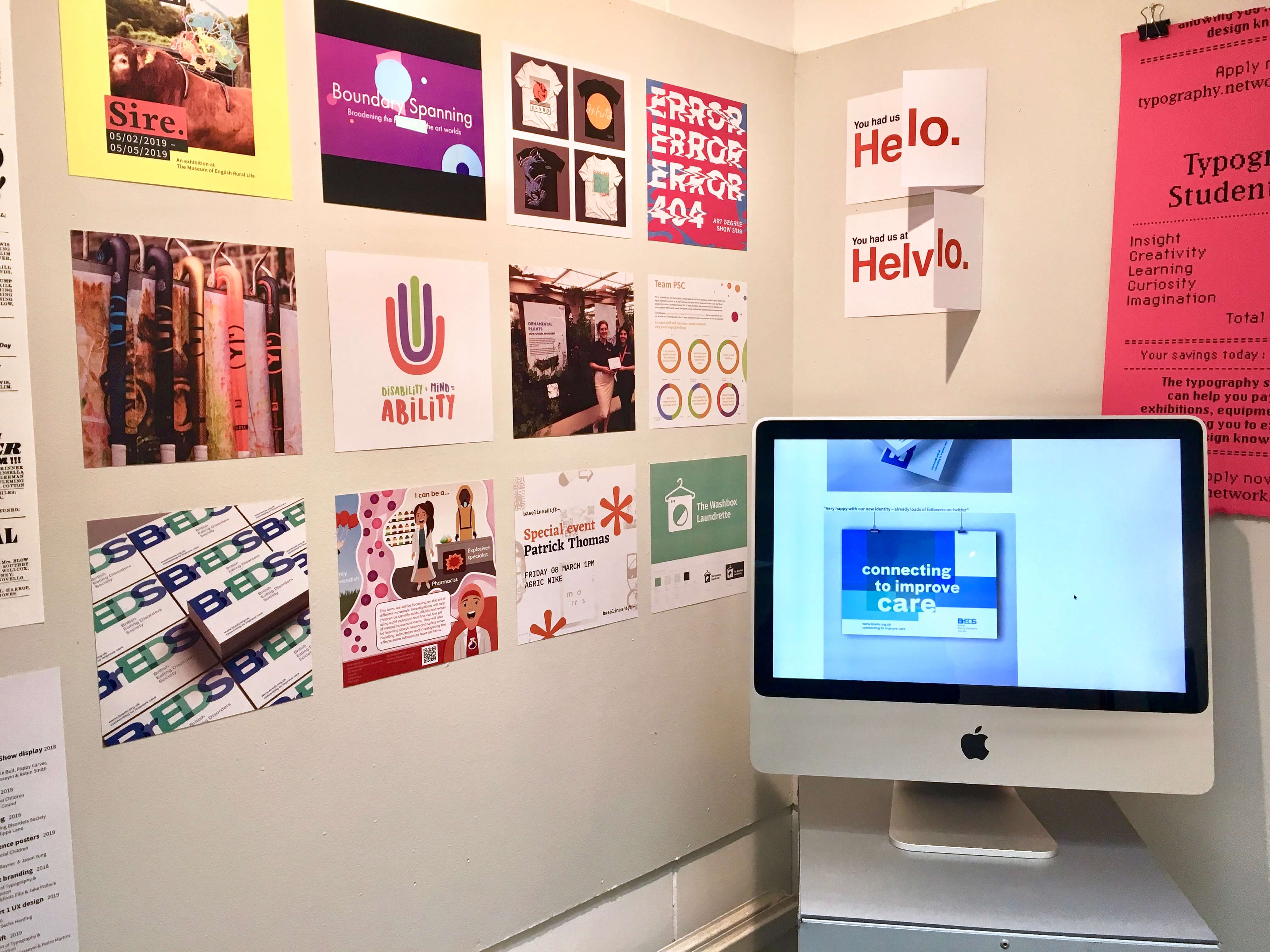

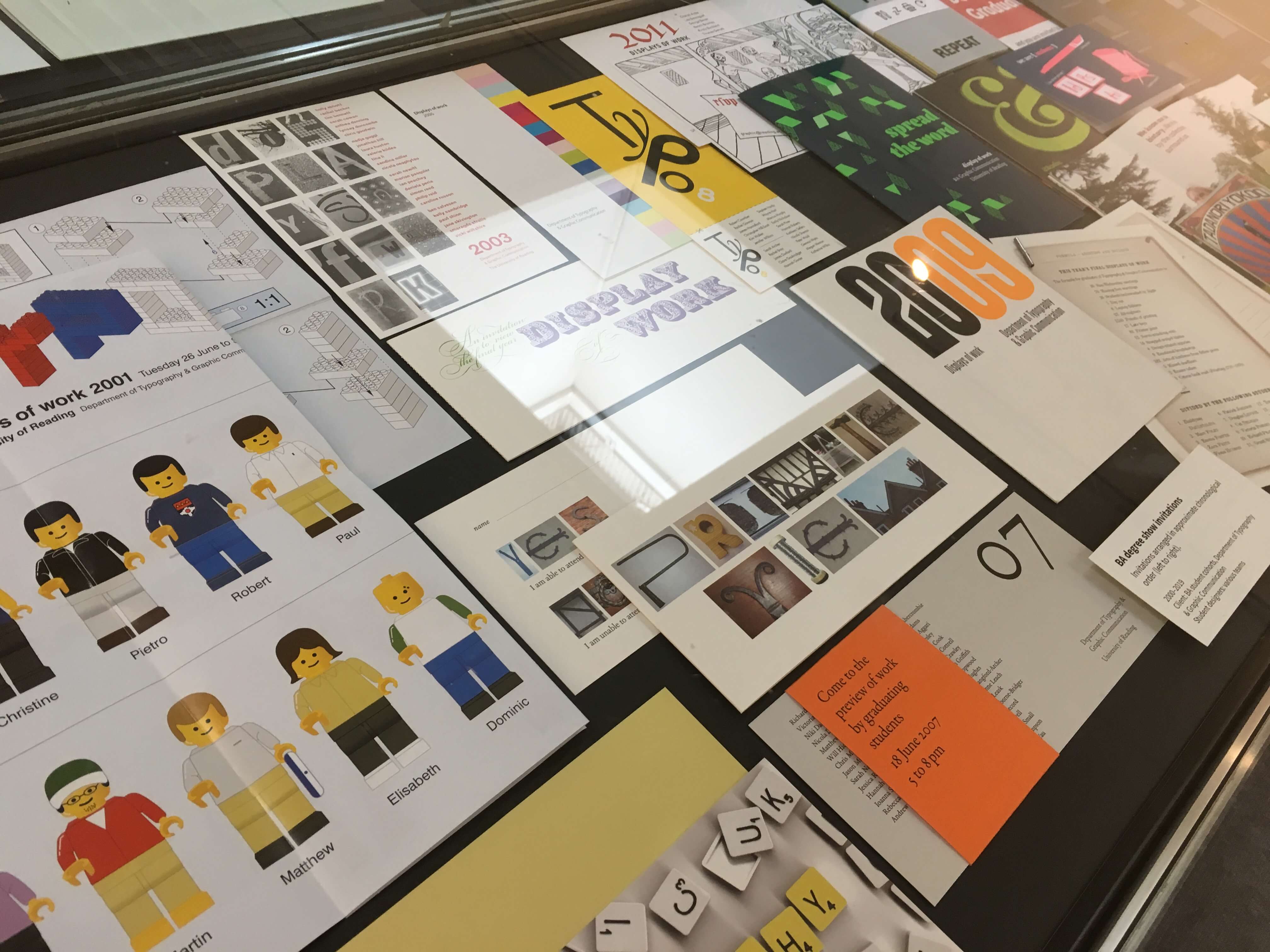
Creating flags to share identities at the Tate Exchange
In March, Typography’s ‘I am, we are … different by design’ project team designed and led a workshop to explore identity and movement as part of the Reading Assembly Tate Exchange. This year’s student team leaders Martha Macri and Seniz Husseyin look back on what made this such a successful day for all involved.
The Tate Exchange is an annual programme of events led by different educational partners hosted at the Tate Modern. Our University of Reading School of Arts & Communication Design were delighted to be invited back for the second year in a row to run our Reading Assembly in the first weekend of March. This year’s theme was Movement. Project teams in the School explored different interpretations of the theme to create fun and exciting activities for the public to get involved with.
Our ‘Different by design’ team for the day included: Camara Dick, Charlotte Prince, Labiba Haque, Liselot van Veen, Malaika Johnson, Martha and Seniz, supported by tutors Geoff Wyeth and Jeanne-Louise Moys. Our team is exploring ways to celebrate and explore diversity in creative disciplines. Our interpretation of the theme ‘movement’ was focusing on global movement and embracing everyone’s individual identities that reflect our diverse personal experiences, culture and journeys. Flags represent collective identities, so we wanted our participants to create flags that express their personal identities that we could collate to form a larger, composite and representative flag for the day.
Project management
In our weekly team meetings, we brainstormed and discussed ideas of what we could do for the workshop with the theme of ‘movement’. As a team we worked together and developed our flag idea. Martha and Seniz co-led the team, which meant we kept in regular contact with Anna Kontopoulou (the School’s Reading Assembly coordinator), identified what equipment and materials were needed and made sure all interim deadlines were met.
To ensure our activity would run smoothly on the day, our team set up a practice run of the workshop to test the process, equipment and to check for any altercations along the way. This proved a success as we perfected any aspects that needed changing and felt more confident as a whole. Overall, the planning process was spread over a few weeks.
On the day
Our workshop activity was designed to allow the public to express their identity through designing their own flag. We supplied them with paper to design on, readymade cut-outs of coloured paper and recyclable materials, as well as the option for them to create their own shapes and images. We encouraged the public to create anything personal to them and also displayed our team’s readymade bags to inspire or stimulate people’s creations.
Once the flags were created individuals handed them over to our scanning and printing section. We scanned the flags, not only to team. Our team printed these onto transfer paper and compiled all the flags into one collective flag showcasing everyone’s amazing work. The transfer paper printouts of each flag were ironed onto tote bags, enabling public partiicpants to take home a bag they designed themselves as a souvenir. Who doesn’t love taking things home after am eventful day out with friends and family…? We noticed that participants of all ages really liked this aspect of our activity and were happy to wait patiently to take home something they created, even when our ironing transfer queue was quite long!
Evaluation
The activity turned out to be a success with the table of crafting always being full and busy. We were happy that everything fell into place, ran smoothly and that our activity was popular to be a part of in the room on the day, highlighting that allowing people to express their identities is a good thing. The variety and quality of work the public created was wonderful to see and the collage of flags were inspiring to everyone.
Our team were very pleased that we received such positive feedback. We had people of all ages and backgrounds take part, from toddlers to Danish cabinet ministers, creating different interpretations of their own identity. All, however, expressed that they enjoyed their time and liked the idea of the activity – some people even stayed on the floor for hours. They especially enjoyed being able to take a tote bag home with something on it that they took their time creating. One person said: “I loved all of it. I would do it all over again”, which shows the positive impact it had on members of the public. The encouraging feedback has left our team eager to continue this workshop activity next year at the Tate Exchange and hope to be invited back.
Early lithography around the world: objects, processes, and experiences, workshop report
Early lithography around the world: objects, processes, and experiences was a workshop that was convened by Reading PhD candidates Borna Izadpanah, and Wei Jin Darryl Lim. It was conceived together with, and led by Professor Emeritus Michael Twyman, and was held in the Department of Typography & Graphic Communication on the 27 March 2018. The workshop was planned as a series of informal sessions and brought together a select number of colleagues working internationally in various disciplines and professions, from conservation and restoration, to type design, and printing and book history.

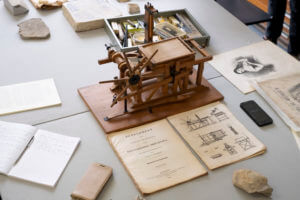
A collections-based approach was central to Early lithography around the world. To that end, Michael Twyman drew upon his personal collection of printed artefacts originating from, and relating to the lithographic printing trade across two centuries, and set up a rare exposition – a miniature exhibition to be specific – of his personal collection of items, supplemented by the lithographic stones collection, and ephemera collection of the Department of Typography & Graphic Communication. Artefact- and materials-handling was instrumental to the delivery of the workshop, and at various instances participants were strongly encourage to handle, study, and observe – by sight and touch – the visual and material nuances of a variety of objects: from a miniature model of a star wheel press, lithographed trade cards, manuscript bills of sale, to limestone fragments from France and from the Solnhofen quarries in Bavaria.
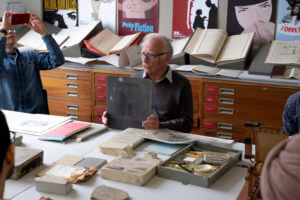
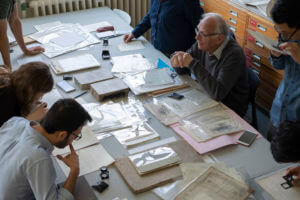
Divided into several parts, the workshop was loosely arranged around the themes of lithographic stones and their sources, trade tools and technology, operations and production, and products of the press. Our session began with Michael presenting and highlighting the intrinsic importance of lithographic stones to the nature of the technology and trade, regardless of geographic location, or scale of printing operation. This intense, in-depth presentation about the geological qualities of the lithographic stone bred fertile discussion by drawing in a new area of research consideration, with participants sharing anecdotes and bringing contributions from their own areas of expertise and interests. This was followed by a discussion about the lithographer’s tools – pens, crayons, and various paraphernalia employed by writers working in the trade, and the technicalities, considerations, and issues behind the operation of a lithographic press. The printed products emanating from presses were examined next; with participants learning how to identify specific characteristics that gave clues into how a lithographed piece might have been originated, multiplied and printed. Particular attention was paid to distinguishing between writing done in reverse on stone, and work done the right way round on transfer paper, and then transferred to stone. Various types of artefacts – books, pamphlets, newspapers, ephemera – printed from the various sub-branches of lithographic technology were also meticulously examined and handled; including products printed by gillotage, a process that was used to convert lithographic marks made on stone (or transferred to it) into relief images.
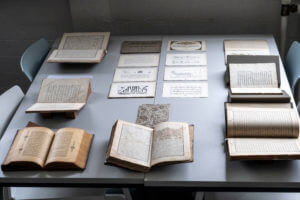
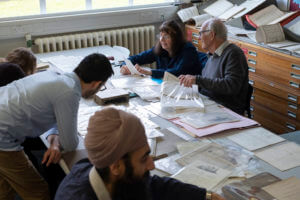
Numerous productive discussions punctuated the day. Participants actively drew connections and shared insights from their own specialisations in Persian, South Asian and Southeast Asian branches of research, and shared understandings from their awareness of localised conditions of adapting and using lithographic presses, the qualities of how specific Asian scripts were rendered, all in relation to the topic of lithography. Attendees that participated in Early lithography around the world included Emily Müller, paper conservator and Andrew W. Mellon Fellow at the Metropolitan Museum of Art, New York; Jasdip Singh Dhillon, book conservator with the Oxford Conservation Consortium with a keen interest in Sikh lithographed books; Aardarsh Rajan, Masters by Research candidate and type designer; Suman Bhandary, Masters in Typeface Design candidate; Sallie Morris, the Typography Department’s Collections Research Assistant; Professor Fiona Ross, a type designer and historian; and Vaibhav Singh, typographer, typeface designer, and British Academy Postdoctoral Fellow at the University of Reading.
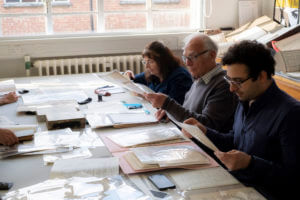
Join us for our May postgraduate visit opportunity
We’re delighted to let you know we have scheduled another visit opportunity for prospective MA applicants to visit us. The Department of Typography & Graphic Communication warmly invites prospective MA applicants to visit us for a postgraduate open day. The visit opportunity will be held in the Department on Thursday 2 May 2019 from 12.00–14.00. It’s a fantastic opportunity to find out more about the specialist postgraduate study routes we offer through talking to our subject experts in Book Design, Communication Design, Creative Enterprise, Information Design, and Typeface Design. We’ll also be able to see highlights from our world-renowned Collections and examples of past student projects and enjoy our current exhibition on 20th Century Persian newspaper types.
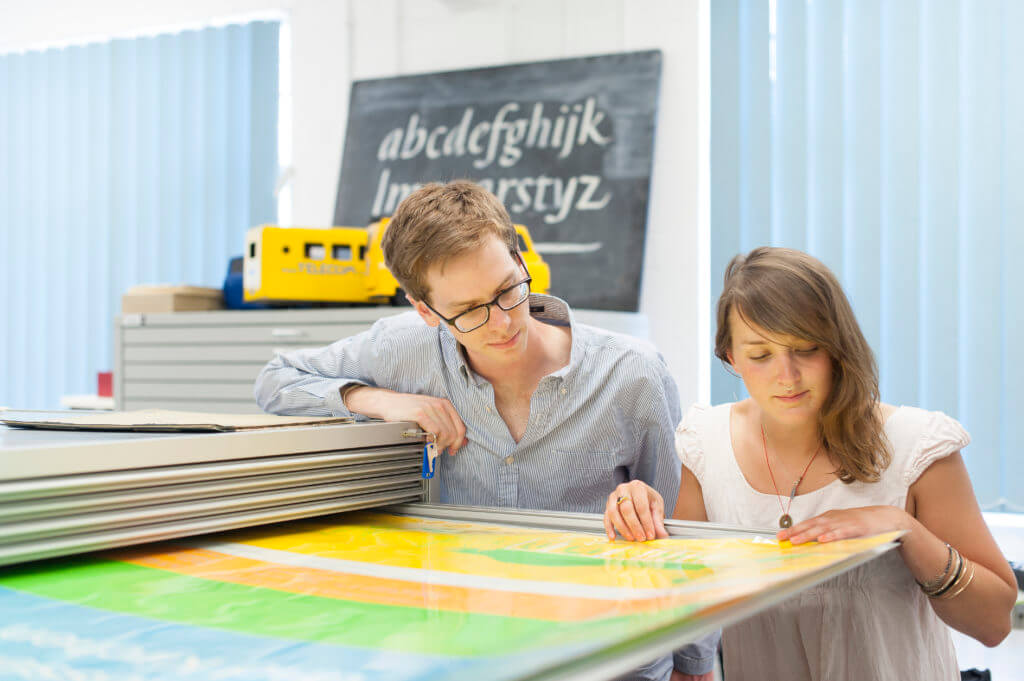
We’ve refreshed our postgraduate taught programmes to build a stronger, integrated typographic foundation for research and practice across all programmes and specialist pathways. These changes include a new general Communication Design pathway to complement our well-known established pathways in Book Design, Information Design and Typeface Design. These four specialist pathways are all offered as part of our newly renamed MA Communication Design – the ideal degree for anyone wishing to develop their professional practice within a world-class research environment.
In addition to the practice-intensive pathways for the MA Communication Design programme, we also offer a multidisciplinary Creative Enterprise programme and two research-intensive programmes. Our MA Creative Enterprise is designed for individuals who wish to combine their study of research and practice in Communication Design with studies of management and law for the creative sector. Our MA Research Typography & Graphic Communication is the ideal route to prepare you for independent research and doctoral study and our MRes Typeface Design is a bespoke route for experienced, practicing typeface designers who want to develop a deeper understanding of the historical and theoretical aspects of their field.
For joining information and to register your interest, please email Victoria Gifford – typography@reading.ac.uk.
Ravensburg ’19 and the D&AD awards
Our collaboration with DHBW Ravensburg saw 40 German students join us for a day of presentations centred on the D&AD New Blood awards. The exchange also saw five Part 3 students, along with Erasmus-supported Teaching Fellow Sara Chapman, make the trip in the other direction.
Lauren Towner: The life of a professional illustrator
Lauren Towner came to speak with our undergraduates about the experience of creating illustrations on-demand, on-brief and on-time, and what designers can learn from the perspective of other specialist in any creative process.
Making work experience pay: Introducing the Reading Internship Scheme
Claire Mack and Holly Forsyth outlined the opportunities for paid graphic design internships, co-funded by the University.
‘It’s never right the first time’
Alison Black led week 3's Baseline Shift talk on approaches to academic writing. She focused on the emotional experience of writing, the barriers that stop us settling down to write, and the mindset required to produce good writing.
